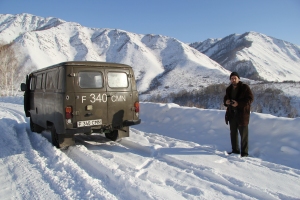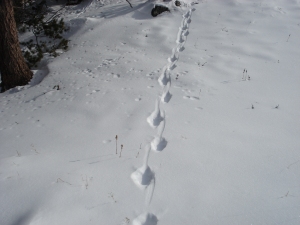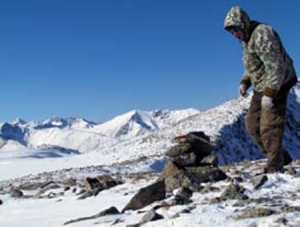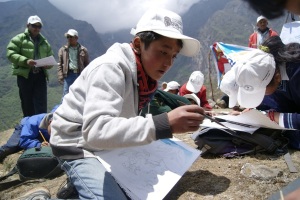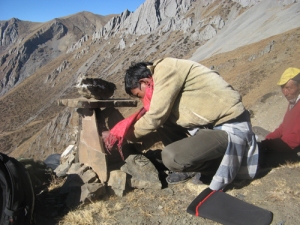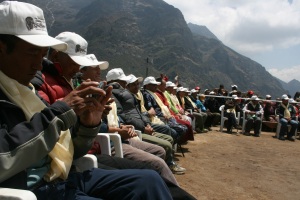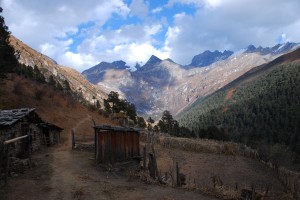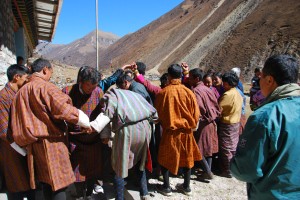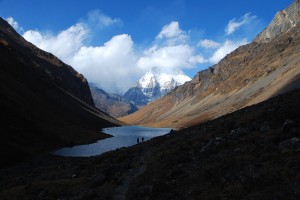Harsh weather in Kazakhstan calls for reliable transportation!
Updates from our Nepal Program
With the end of the year approaching, our US-based staff has been laden with the gift of updates from our partners abroad! Notably, our Nepal program has been expanding and progressing in exciting ways! Regional director, Som Ale’s reports have shown us that our community engagement plans are both effective and quite fun.
“Two things make and keep a society great and long lasting: its people and pristine nature. ” -Som Ale
Many great societies of past (for example, Mayan, Egyptian, Easter Island societies) collapsed because of the environmental collapse due to habitat destruction and over harvest of local biota. The notion that man and nature are inseparably bound in an intricate web of interrelationships and interdependencies should be realized and essentially percolated into minds of people from young age. This level of awareness and education should start with young students and depends on how they interact with nature in the outdoors – that is, they learn much in the field. We believe in experiential learning. In other words, “field is the classroom”.
The education component of snow leopard project in Nepal has been to organize school youth, as snow leopard scouts, so they have collective voice in raising awareness in their local communities and society at large. The program trains and supports high school youths (Snow Leopard Scouts) to work with local teachers, guardians, park rangers, livestock herders, and other stakeholders, in community-based wildlife monitoring targeting snow leopards and prey species. Snow leopard scouts work with herders, their parents, and other community stakeholders. The hidden agenda is to help curtail people-wildlife conflicts, exacerbated by lack of awareness and commitment to wildlife conservation on some segments of local population. The Conservancy has reached two objectives:
1. Elevate local students’ awareness level on snow leopards and local biodiversity by conducting special students’ snow leopard/environmental camp while delivering a “once-in-a-lifetime experience” featuring wildlife watching, essay-writing and nature drawing
2. Create a net-work of young snow leopard scouts who promote snow leopard conservation
And in 2013 we plan to reach our final objective:
3. Make the snow leopard network self sustainable at the regional level so the network runs the activities at local level on its own.
The snow leopard scouts program has been and will continue to be popular not only among students but also among guardians, park and buffer zone authorities in Everest. Activities in several frontiers have been recommended –
— Continue the environmental workshop and field-excursion, every year, in which new batch of students will get exposure.
— Continue publication of snow leopard scouts booklet series.
— Find mechanisms for self-sustainability (Already, a portion of the interest of the snow leopard savings and credit program comes directly to support snow leopard scouts activities)
— Equip students with cameras to track snow leopards.
News from Tshewang and Rodney from Bhutan
On Tuesday, October 16, Rodney Jackson posted on his Facebook page:
“I’m off to Thimpu, Bhutan for three weeks to work with our partners to establish a community-based stewardship program. I will report back at the earliest opportunity!”
Here is the first report on the trip from Tshewang Wangchuk, the executive director of the Bhutan Foundation and member of the board of the Snow Leopard Conservancy:
Rodney and I made the two day trek into the mountains and are now in Soe Dangojang, at the base of Mt. Jumolhari, Bhutan’s sacred mountain.
For the last two days we were working with local communities, the park officials and other government officials to discuss details of a community-led snow leopard conservation program for the region. Today we will hike with community members to set up their camera traps. We will then cross the ridge, two lakes, a big pass and then move to the next community, Soe Yaksa.
During the day we get clear blue skies, great view of the peaks, but night time temperatures are well below freezing. Cell phone coverage is amazing here, but the internet is very very slow – so we will send pictures later. However from today we are behind another mountian so there will be no cell phone coverage.
There is a lot of snow leopard activity in the region and the people are excited about working together to minimize yak mortality, increase their income, and conserve snow leopards.
Will send you more updates once we have better access to the internet, which will only be around the 29th or so. Best wishes from the base of Mt. Jumolhari where the yaks are strong, the snow leopards thriving, and internet rather slow (but at least we have it).
There and Back Again: An Update from the Altai, September 2012
Greetings from Gorno-Altaisk, the capital city of the Altai Republic. We arrived here three days ago and it really feels like an emergence into the modern world. The streets are bustling with people living their city lives, destinations in mind, plans to meet and people to see. Gorno is a picturesque city, nestled between rolling green hills and lined with trees, changing with the arrival of autumn–the city will turn on the heat soon, warming the lives of the Siberians who endure a frigidly cold winter that lasts until May.
It couldn’t have been a better time to arrive, as we got to celebrate the 84th birthday of the city with what seemed like the whole population last night. The city square (where the Snow Leopard Day Festival will be held in just one week) transformed into a stage filled with music, dance, light shows and fireworks. Children sat on shoulders, teenagers pushed through the crowd, old women watched in awe and we just soaked it all in.
We are staying in the apartment of our translator, Natalya and her two young daughters. Much time is spent in humorous ways of communication: funny faces, humming and singing, and the very few words any of us know in our non-native tongues. Kids are always the most fun to communicate with when there is a lack of linguistic relation.
Now that I’ve brought you up to speed with current life, let’s go back two weeks to where I last left you.
—
We left Kosh-Agach after helping in the museum interviewing students, teachers, and local conservationists. This is a much deserved shout-out to Alice, SLC volunteer, who has been a great help throughout the trip, especially when it comes to entertaining the unusual amount of babies that have been present during our interviews. Without her, our film would be laden with the hiccups, screams, laughs, and chirps of Russian infants. And more notably, Alice has contributed countless valuable questions that will enrich and further our understanding of the development of SLC’s work in the Altai.
Our journey back along the road that we came signified the turning of our trip toward the our ascent back to the States. Chiminsky Pass, the paved two-lane highway that cuts through the Altai mountains, is said to have been built on the bodies of the Russians who did the work, which means this highway was extremeley dangerous and difficult to build but now allows access into some of the most remote territories on earth.
The thick clouds dispersed in front of a beautifully sunny day made for some of the most dramatic scenery as we twisted down in elevation to our next destination, Chui-Oozy, a small eco-tourism settlement. Before arriving, we witnessed the most breathtaking double rainbow in the existence of my little life. We all sat in awe, in the middle of the empty highway, staring, mouths open.

We spent three days in Chui-Oozy, under the hospitality of Galina, a kind-eyed Altaian woman who let us interview her about tourism and her perspective of the current issues in the Altai and her hopes for the future. We also visited a petroglyph site that depicted life up to 15,000 years ago. Wild animals, people, and the heavens were all strewn about the rocks–such ancient history so tangible and present. I felt human, and a part of such a truly amazing history of human consciousness.

We left Chui-Oozy, toward Inegen, a small settlement along a truly terrifying road that, as the locals told us, government officials won’t even travel. To travel this road was the best choice we could have made. Inegen is a magical place, as if from a fairytale you only fantasized about as a child. Set along the jade-green Khatun River and nestled in a lush, green valley between tall, protective mountains, Inegen probably only has 100-200 residents. It’s unique placement in the Argut River Valley, is a microclimate, perfectly abundant with healthy soil, sunshine and rain to have endless gardens. Each house is enveloped in green, thick gardens bursting with colorful flowers, perfectly delicious produce, and apple trees bearing the most crisp, sweet fruit.
We stayed in Irbis Eco-lodge, a small settlement on the outskirts of town owned by Olga and Slava, a sweet couple who have lived in Inegen all of their lives. I was gleeful, admiring the craftsmenship of their wooden yurts and felt blessed to spend a week sleeping in these round homes that I have had the aspiration to build ever since I spent time in Mongolia. With a sweet little dog named Malush (little one, in Russian), a fuzzy, furry white goat, and a lone horse, we spent our days enjoying the simplicity and quietness of life in Inegen. Again, we were greeted by the town with a curiosity that turned in to honest hospitality. And we met people passionate about saving the snow leopard and protecting the land that these people share with the wild animals of the Altai. We visited the school, visited peoples’ homes and shared countless cups of tea, homemade bread and jams, preserved vegetables and various salads.
It was hard to leave this place as this is the life I strive to live: simple, honoring nature and our place in the family of things, harvesting food grown in the yard, building the home I live in.
We left as dawn broke on Friday and as our trusty Russian utility van left the last of the bumpy, unpaved, dirt roads to be traveled on this trip, I felt a wave of nostalgia (already!) for the unpaved life, the gritty, the unpredictable, the undeveloped–a life that I revel in each time I leave the comfort of my own.
-Lucy
Nepal Snow Leopard Scouts Update August-September 2012
Snow Leopard Conservancy – Nepal program
Snow Leopard Scouts – Lower Mustang
Street Drama: Snow Leopard Scouts – Lower Mustang performed the snow leopard street drama “Mountain Queen, the Snow Leopard” in Muktinath during the Yartung (horse-riding) festival (2-3 August 2012). Yartung, the most locally popular annual festival in Mukinath, attracts several hundreds of people from Mustang, Manang and Dolpo districts. Yartung is celebrated in almost all sizable villages in these districts but the Yartung in Muktinath is special because of its strategic location – Muktinath, the holy abode for Buddhists and Hindus alike. The recently formed snow leopard scouts committee members along with other motivated students brilliantly performed the snow leopard drama. The main aim of the street theatre was send a strong snow leopard conservation message to locals, civil servants, and national and international visitors. Students also performed local cultural dances and songs. The Snow Leopard Scouts-Lower Mustang plan to publish the underlying story of the street drama in the form of a colorful comic book for a wide circulation.
Students performing street drama: Note the snow leopard trapped in poorly-constructed livestock corral

Local people watching street drama

Horse riding event during the Yartung festival

Snow Leopard Scouts – Pokhara, Kaski Chapter
Interschool arts competition: The Snow Leopard Scouts – Pokhara, Kaski chapter has been registered as Snow Leopard “Open Scouts Troop” of the environmental wing under Nepal Scouts – Kaski. The Inter-school snow leopard art competition was held on 8 September 2012 in Nepal Scouts – Kaski office. The program was jointly organized by SLC’s Nepal program, Annapurna Conservation Area Project, and Nepal Scouts, to motivate and mobilize youths for conservation and education activities. The program was inaugurated and chaired by Sarada Prajuli, Kaski District Commissioner of Nepal Scouts. In total, 45 students and 20 teachers from 31 schools, 10 special guests from different organizations, 12 members from Nepal Scouts-Kaski, and a few reporters from local newspapers attended the program. Students were instructed to draw a comic-style nature drawing depicting snow leopard and its prey. The essential element of the arts competition was that students were to include the images of snow leopard and associated species “conversing”! The best three students were awarded during the occasion. The participants watched wildlife documentaries and were given lectures on the importance of snow leopard and biodiversity conservation. Nepal Scouts hosted the program – led by the District Joint Commissioner, Dhiraj Thapa. The event was highlighted in three local newspapers (Adarsha Samaj, Himjut, Kalam and United Pokhara).
The snow leopard event banner (note the snow leopard image on the background of “snow leopard scouts logo”)

Snow leopard arts display for juries and others for inspection

Russian Altai Report August/September 2012
I write you all from the frontier town of Kosh-Agach and the town is bustling with the anticipation of the first day of school (September 1st for all schools in Russia). There are kids running through the streets, extactic about their new school clothes and supplies and parents with furrowed brows, double checking that everything is in place before summer ends. Along with the end of summer comes the beginning of winter (as autumn and spring are short lived here) with the first snow fall often arriving in the beginning of October.
We’ve settled nicely in our little hotel room, sharing quarters with the family that owns Hotel Centralnaya. By now we are famiiar with their two baby boys and countless family members that are in and out, drinking tea and cooking meals in the kitchen. There are lots of laughs even with our language barrier and they find it funny that we seem to make friends with new guests every night, discussing everything from Kyrgz farmers, Russian border guards, and the slightly sensitve subject of the harvesting of Red Deer antlers for traditional medicine. Many people are curious about us and ask with honest curiosity about our work and what it means to us. All of these answers become more clear every day as we visit local activists, organization leaders and teachers.
So far, our most notable interview has been with Maya Erlenbaeva, cultural expert of Altaian culture (she’s Altaian, herself!), and former deputy-director of Quiet Zone Ukok Nature Park. She is a lovely woman, mentioned in Darla’s last visit to the Altai, who lives here in Kosh-Agach and has a deep understanding of the importance of conservation and preserving the culture and traditions of the native Altaian people. Her son, Tengis, mentioned in the last blog entry, is truly beautiful.
Maya and Tengis in his warm wool vest:

Natalya and I interviewing Maya:

We are all very happy with our first official interview, and we fimed the whole thing! One of our many goals here in the Altai is to gather enough footage and interviews to make a short film about the Altai. We know that Altaian culture has a lot to teach the rest of us humans living on earth and their reverential relationship with the snow leopard must be shared.
Maya explained that Altaians believe (they are traditionally a Shamanistic culture) that the snow leopard is the guardian of their ancestors. Up in the high mountains, these ancestors live as spirits and the snow leopard is the intermediary between the living world and the spiritual world. A person who kills a snow leopard will be punished by the spirits, so it is forbidden to kill this totemic animal.
–
–
Maya’s words were inspiring, informative and necessary for the world to hear. We are thankful for her ardent participation and look forward to sharing more with you all when the film is completed!
We also finished tidying up and adding our own touch to the Snow Leopard Museum and visitor center that just opened 10 days ago! Here is the display we created:

And I will leave you with a gorgeous shot of the Altai Mountains:

Russian Altai, August 2012
Hi Everyone,
It’s been two weeks since I departed San Francisco for the Altai Republic in Southwestern Siberia. The long plane ride from SFO-LAX-Moscow-Novosibirsk was tiring and it was a relief to meet up with Alice Clark (volunteer for Snow Leopard Conservancy) at the Moscow Airport. I found out upon arriving in Moscow that my baggage had been misplaced along the way! I was worried about the idea of not having my bag (especially my warm clothing) for the upcoming expedition in the Siberian mountains. Our expedition was lead by Biosphere Expeditions (B.E.), an environmentally-focused tour group determined to join scientific field work with everyday people. Jenny Kraushaar, veterinarian and big cat specialist lead us along with Adam Stickler, team leader and Marine Biologist. After a long and tiring next few days, my bag finally came and I tailed the B.E. group a day behind and finally caught up with them. Whew! Let me tell you…it was key to have all of my clothing on this expedition. Once we left the familiar Soviet style city of Novosibirsk (New Siberia), we drove for two days into the Altai Republic. The scenery only got more beautiful as the flat lands drastically changed into vast, green valleys and steep, craggy mountains. To my delight, the Altai Republic is a hub for honey production in Russia. My love for honey seems to follow me as I travel and I was beaming as we passed small wooden stands along the road with Altaian people selling 1.5 litre beer bottles now filled with deep yellow and amber honey.
After we went through border control (our camp was just a few dozen kilometers from the Mongolian border), we drove through the darkness to the base of the Talduair mountain range in SW Siberia. This area is not known for an evident population of snow leopards but with a growing prey population, Biosphere Expeditions has hopes to find evidence that these mountains are suitable snow leopard habitat. So, we set out as amateur scientists into the long valleys and high mountains of the Altai in search of snow leopards and their prey species. We had multiple methods of recording our data: scat collection, camera traps, recording of tracks and snow leopard scrapes. It was very fun to spend hours in the mountains, surveying the landscape with binoculars even though most days did not produce sightings of argali or ibex and never of a snow leopard. The Chickachev Ridge, just on the other side of the Mongolian border is known as a hot spot for snow leopards but unfortunately due to permits, we weren’t allowed to survey the area. Fear not! We found plenty to do and were excited to see the wild ibex and argali while in the Altai, confirming that the area is promising for the flourishing of our beloved snow leopards.


Here are some highlights from our expedition:
Among many treks, our voyage to a remote glacial lake was incredible! After traveling through the lush green valley, we came to a wall of rocks that we climbed with the guidance of Oleg, our guide and human mountain goat. Not only did Oleg carry himself, his large pack, and fire wood, but he also carried the pack of someone else! He scaled the crumbling skree and dense boulders with grace. There were plenty of Lord of the Rings comments and I couldn’t help but feeling like Gollum, grasping from rock to rock as we climbed higher and higher 🙂 Once atop the mountain of boulders, we set eyes on a stunning glacial lake, probably only seen by a handful of people on earth. The camera traps were atop the high ridges and we left the advanced group, who planned to retrieve the cameras the next day. Unfortunately, a heavy blanket of snow covered them during the night and they were forced to come back to base camp, soaked from cold rain and snow, before getting the cameras.
This is Oleg making the treacherous ascent:


Here is a snow leopard scrape we found:

Alice and I at the lake:

We also were able to do some anthropological research and touring of the area. Genia, the Russian scholarship student of Anthropology from Novosibirsk brought us on a tour of ancient burial mounds in the area. Much of the Altai and surrounding areas are precious anthropological sites, with burial grounds and petroglyphs dating back to 1,000 B.C. She brought us to see Turkic burial grounds or Kurgans (mounds of stone 5-10 feet in diameter surrounded by square stone boundaries dating between 1st and 12th century A.D.), Scythian burial grounds (with circular stone boundaries representing the sun, moon, and circular nature of life and death), and petroglyphs that laid among the mountains speckled with petrified wood in the steppe. Genia spoke of the importance of these cultural monuments and naturally I thought of the controversy of building a pipeline through the Ukok Nature Reserve in SW Altai. This horrible prospect the pipeline is deeply rejected by many Altaian people as it will disrupt one of the most sacred sites in all of Siberia.

Wan Lin and I compiling data in the mess tent
On our last day with Biosphere, we took the Land Rovers across the steppe to meet local herders and ask them about their experience with snow leopards, pallais cats, argali and ibex. This was very interesting as we had little interaction with the local people and we wanted to know their views on snow leopards. What we learned is that snow leopards have very little presence in this region of the Altai; the herders expressed an indifference to the animal as they haven’t had negative encounters with the cat. The herders live a harsh life on the Siberian steppe and rely greatly on their livestock for sustenance and income. The pallais cat (manul in Mongolian/Russian) has a greater presence and due to their smaller size, do not threaten the livestock.
This concluded our two weeks with B.E. and Alice and I were dropped off in Kosh-Agach to meet our lovely interpreter, Natalya, and attend a meeting involving WWF Altai and Mongolia. The meeting took place in the new Snow Leopard Musuem, which is a beautiful wooden yurt with a traditional low door that forces all visitors to bow as the enter the space. We were able to gather that snow leopards are very present within multiple regions in transboundary of Russian-Mongolia. The goal of this meeting was to write a proposal for the Darwin Initiative Award which assists countries that are rich in biodiversity but poor in financial resources to meet their objectives, this specific objective being to increase the livelihood of local people while decreasing the threats to the endangered snow leopard. The meeting was centered around the goal of the development of souvenir and goods production into the National and International markets. With cooperation between Mongolian, Russian and British experts, Alice and I eagerly soaked in the complicated process of developing a comprehensive and culturally sensitive proposal.
Now, we relax! Ah, yes, the sweet comfort of a bed with a hot shower and fresh bread, cheese and Altaian cuisine. We were treated to a lovely dinner with Maya, a woman who is a cultural expert of the Altai and fantastic cook, to boot. She graciously invited us into her home and served us a dinner of sliced meats and cheeses, cucumber and tomato salad and a local dish of fresh lamb, rice, and vegetables called Plov. The real cherry on top of the night was when she shared her white honey from Onguday, which tasted sweetly medicinal, like it healed with every spoonful! With the help of Natalya, we conversed with Maya about working in the Altai and her visits to the states. And on top of it all, we were delighted to meet her 8 month-old son, Tengis (‘of the heavens’ in Altain).
We have just met with Chagat, the director of the Foundation for Sustainable Development of the Altai (FSDA) and we will carry on our journey tomorrow morning.
Sending positivity from the Altai! This place is truly beautiful, in so many ways.
-Lucy O’Dea, Education Program Officer of Snow Leopard Conservancy
p.s. I would love to post more photos but the internet is acting up! More soon!
Field Report from Jomsom Mustang, June 2012
Greeting from Annapurna!
I descended to Jomsom from the alpine pasture, yesterday, 21 June. I had arrived in Jomsom (Mustang) on the 18th of June on a jeep. There was no guarantee of flights from Pokhara (weather problem), so I had to hire a jeep on 17 June to reach Mustang in the morning of 18 June — the day when the snow leopard scouts committee was formed.
Each and every year a new eco-club network is organized in Annapurna Conservation Area Project (ACAP) – Jomsom in which 11 members will get selected as the eco-club members, to serve for that year, from the student representatives from 11 different schools. This eco-club network is also the snow leopard scouts committee. All members are typically the sixth, seventh and eighth graders. There are reasons why we wish to have the students from 6, 7, and 8 grades [12 to 15 age group] as the snow leopard scouts: This is the age when children are most receptive about everything including nature conservation. These scouts along with other students, teachers, and governmental workers (over 35) were briefed on snow leopard activities. The new snow leopard scouts were then led to environmental/snow leopard camp from 19 to 21 June in the alpine pasture (camping elevation c. 4,000m). In total, 11 new members, one old snow leopard scout, one herder, one local teacher participated in the environmental camp. The program was coordinated by ACAP ranger, conservation education teacher, and SLC coordinator. Among others, the following activities took place –
1. Environmental debate. Students were grouped into two and they were given relevant materials on snow leopard and other local wildlife species to go through prior to the debate. The discussion and debate took two hours. The aim was to assess their interests and enthusiasm on snow leopard and other local flora and fauna.
2. Nature drawing and field-note writing.
3. Snow leopard sign tracking and blue sheep observation and classification
4. Learning about and installing cameras on strategic snow leopard walking trails.

Note that this year students are going to install in total three cameras, NOT nine, as in 2011. In 2011, because the snow leopard scouts (lower Mustang) were able to capture three distinct, adult snow leopards, the plan for 2012 is to set three cameras in best locales where the probabilities of catching the snow leopard is highest. The objective was to monitor the three snow leopards of 2011 in 2012 also. On 20 June, students — after learning about the nitty-gritty of remote-camera technology and operating system — installed one camera in Vrapsa at the elevation of c. 4,559m. The interesting aspect of this year’s camera trapping was that OLD snow leopard scout was instrumental in guiding fresh snow leopard scouts.

Also attached is a photo image, not from Annapurna snow leopard scouts event, but that from Mt. Everest. If you remember well, I informed you earlier that I, as the representative of the Snow leopard Conservancy, was awarded a snow leopard dummy that students and teachers on Mt. Everest prepared – a strong indication that snow leopard conservation and education program so far conducted have been well received. This was presented June 5, the world environmental day, amid a huge gathering. This was also the day when snow leopard scouts, from eco-club members, were formed to represent the entire Khumbu. Talk to you later. Cheers, Som PS: I am off to upper Mustang tomorrow, 23 June, for ten days or so.
Reported by Som Ale our Regional Director for Nepal Education and Conservation
Mongolian Scat Collection, February 2012
Sleuthing for Snow Leopard Conservation through the DNA of Poop By Jan Janečka, Ph.D.
As the bitter wind bites the exposed flesh of my hands, I fumble with my GPS to get a location of the tracks we have just found. Despite my fatigue and the pain in my legs, and the burning sensation in my lungs from the cold, I am excited as I follow the footsteps of a wild snow leopard just a few hours after he or she passed through the area.
We come up to the top of the ridge; the endless Gobi spreads below us its rocky camel-colored steppe-lands. We find what we have been searching for – snow leopard poop. It may seem outlandish that I flew from Texas to the middle of the Gobi Desert in Mongolia, and with my Mongolian colleagues embarked on a 700-mile expedition just to find scats, but with the breakthroughs in genetic analysis, there is a goldmine of information that we can now obtain from the droppings of the endangered snow leopard.
Snow leopards are among the most elusive animals. In addition, they occur in very remote areas hard to reach by biologists and even harder to work in. It is therefore not surprising we have very little information on the abundance of snow leopards in much of the mountainous areas they inhabit.
Yet for conservation, we need to get a handle on the number of snow leopards in an area. Why? Well, conservation actions are expensive and time consuming. To protect the species effectively we need to know in which areas they are threatened and where actions that protect these remarkable animals are most needed. In addition, we need to know if our efforts are working. Genetic analysis of scat can meet these informational needs.
Snow leopards deposit scat in very predictable places and the cold dry environment preserves the genetic material. We put a small piece of scat in each secure sampling tube, along with a desiccant. Back in the laboratory, the DNA is carefully extracted from the fecal material and a small portion of a gene is sequenced to verify that it is from a snow leopard. The scat is analyzed using the same techniques that forensic scientists use to identify evidence at a crime scene. Turns out that up to two thirds of the scats that we thought were snow leopard can be from red foxes. Genotyping of microsatellites provides a genetic fingerprint for recognizing individuals. In the map below you can see locations where we collected the scats of three different cats. By collecting all scats over time, we can estimate abundance.
We have compared camera trapping and these noninvasive genetics scat surveys in the Gobi Desert and found the genetic approach more rapid and cost effective. We have developed a partnership between Snow Leopard Conservancy, Texas A&M University, Mongolian Academy of Sciences, and Irbis Mongolia. Together, and with the generous financial partnership of the Bowman Family Foundation, Mohamed bin Zayed Species Conservation Fund, the Tapeats Fund, and many individual donors, we are finally getting a handle on population information throughout Mongolia.
I am happy for the privilege of experiencing the snow leopard’s harsh realm while working with many dedicated biologists, conservationists, and local communities. Even if I never get closer to these remarkable animals than placing my hand in a fresh pugmark in the snow, or reaching for that next piece of poop, it is still a thrill that through my genetic work these cats are unwittingly contributing to their own conservation.
Reported by Jan Janecka, SLC Partner and Professor of Genetics at Texas A&M University
